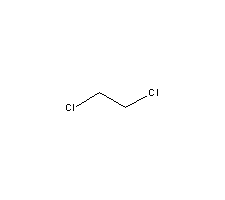|
| English name |
Dichloroethane |
| Alias |
1,2-Dichloroethane; Symmetric Dichloroethane; Ethylene Dichloride; Ethylene Dichloride; Methoprene; 1,1-Dichloroethane; 1,2-Dichloroethylene; |
| CAS RN |
1300-21-6;107-06-2;52399-93-6 |
| EINECS number |
203-458-1 |
| Molecular formula |
C2H4Cl2 |
| Molecular weight |
98.9592 |
| Dangerous goods sign |
 F:Flammable F:Flammable
 T:Toxic T:Toxic |
| Risk term |
R11 ; R22 ; R36/37/38 ; R45 ; |
| Security term |
S45 ; S53 ; |
| Physical and chemical properties |
Property A colorless and transparent oily liquid with a chloroform-like odor and a sweet taste.
Melting point: -35.3°C;
boiling point: 83.7°C;
relative density: 1.2529;
refractive index: 1.4448;
flash point: 17°C;
solubility; soluble in about 120 times of water; miscible with ethanol, chloroform and ether . Can dissolve oil and grease, grease, paraffin |
| Uses |
Mainly used as raw materials for vinyl chloride, ethylene glycol, oxalic acid, ethylenediamine, tetraethyl lead, polyvinyl polyamine and bibenzoyl. It is also used as a solvent for oils, resins, and rubber, dry cleaning agents, extractants for pesticides pyrethrum, caffeine, vitamins, hormones, wetting agents, penetrants, petroleum dewaxing, anti-vibration agents, and pesticide manufacturing and pharmaceuticals The raw material of Micononing and Piperazine. Can be used as food in agriculture? |
 |
|
|
|




